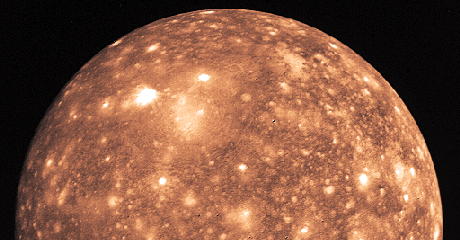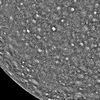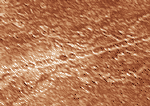
 |
orbit: 1,883,000 km from Jupiter
diameter: 4800 km
mass: 1.08e23 kg
Callisto was a nymph, beloved of Zeus and hated by Hera.
Hera changed her into a bear and Zeus then placed her in
the sky as the constellation Ursa Major.
Discovered by Galileo and Marius in 1610.
Callisto is only slightly smaller than Mercury but only a third of its mass.
Callisto and Ganymede seem to be composed of a rocky core surrounded by a large mantle of water or water ice with an ice surface. Titan and Triton are similar.
 Callisto's surface is covered entirely with craters.
The surface is very old, like the highlands of the
Moon and Mars.
Callisto has the oldest, most cratered surface
of any body yet observed in the solar system; having undergone little change other
the the occasional impact in 4 billion years.
Callisto's surface is covered entirely with craters.
The surface is very old, like the highlands of the
Moon and Mars.
Callisto has the oldest, most cratered surface
of any body yet observed in the solar system; having undergone little change other
the the occasional impact in 4 billion years.
 The largest craters are
surrounded by a series of concentric rings which look like huge cracks
but which have been smoothed out by eons of slow movement of the ice.
The largest of these has been named Valhalla, it
is the most dramatic example of a multi-ring basin. These are
thought to be the results of massive impacts. Other examples are Mare Orientale
on the Moon and Caloris Basin on
Mercury.
The largest craters are
surrounded by a series of concentric rings which look like huge cracks
but which have been smoothed out by eons of slow movement of the ice.
The largest of these has been named Valhalla, it
is the most dramatic example of a multi-ring basin. These are
thought to be the results of massive impacts. Other examples are Mare Orientale
on the Moon and Caloris Basin on
Mercury.
Like Ganymede, Callisto's ancient craters have collapsed. They lack the high ring mountains, radial rays and central depressions common to craters on the Moon and Mercury.
 Another interesting feature is Gipul Catena, a long series of impact
craters lined up in a straight line (left). This was
probably caused by an object that was tidally disrupted as it passed
close to Jupiter (much like comet SL 9)
and then impacted on Callisto.
Another interesting feature is Gipul Catena, a long series of impact
craters lined up in a straight line (left). This was
probably caused by an object that was tidally disrupted as it passed
close to Jupiter (much like comet SL 9)
and then impacted on Callisto.
Unlike Ganymede, with its complex terrains, there is little evidence of tectonic activity on Callisto. While Callisto is very similar in bulk properties to Ganymede, it apparently has a much simpler geologic history. The different geologic histories of the two has been an important problem for planetary scientists; (it may be related to the orbital and tidal evolution of Ganymede). "Simple" Callisto is a good reference for comparison with other more complex worlds.